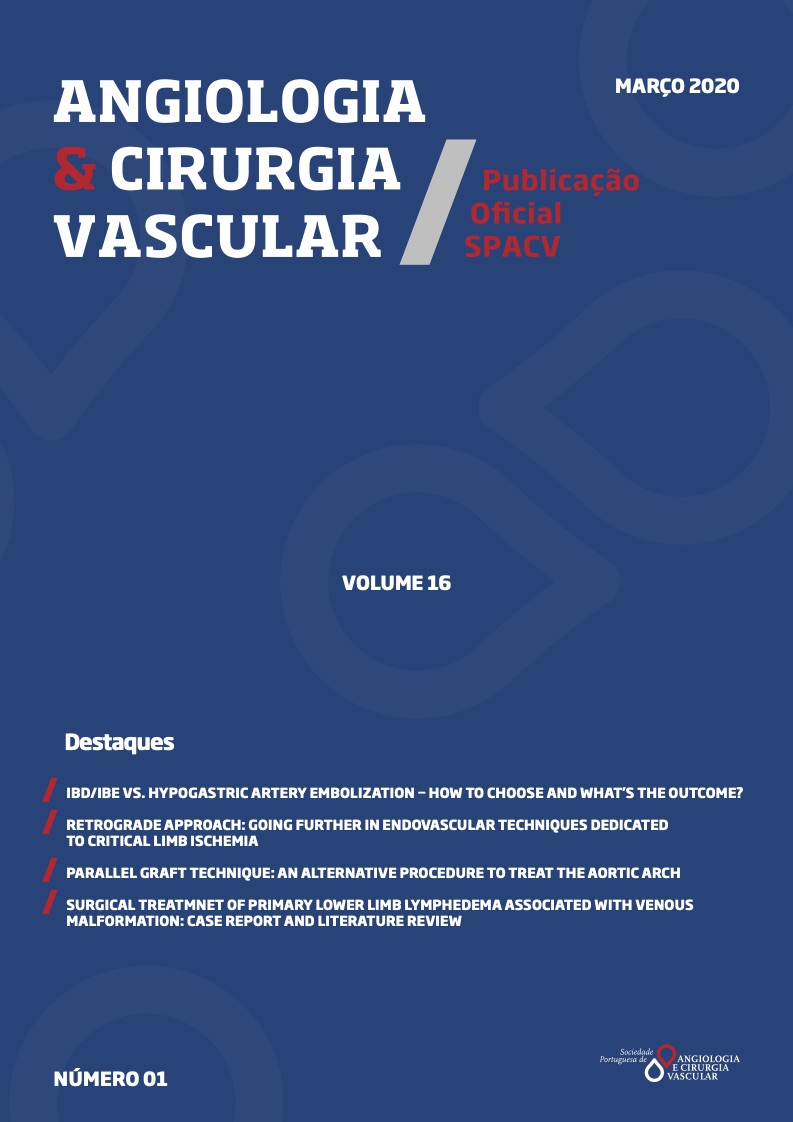DEEP FEMORAL ARTERY PSEUDOANEURYSM AFTER ORTHOPEDIC PROCEDURE
DOI:
https://doi.org/10.48750/acv.181Keywords:
Pseudoaneurysm, Deep Femoral Artery, Orthopedic Procedures, Endovascular, Coils EmbolizationAbstract
Introduction: Most of the deep femoral artery (DFA) pseudoaneurysm (PSA) present asymptomatically or as a pulsatile mass. Clinical signs are variable and, normally, result from compression from adjacent structures but when ruptured it may present as haemorrhagic chock Symptomatic PSA should be treated. However, the decision to treat asymptomatic PSA is controversial. The majority of small PSA (less than 20–30 mm in diameter) are prone to spontaneous thrombose within 4 weeks, so literature recommends observing small, asymptomatic PSA and treating only if they enlarge, do not thrombose, or become symptomatic.
Materials and methods: The authors present two cases of PSA from a DFA branch after an orthopedic procedure.
Clinical case I – 83-year-old female admitted in the emergency department with left femoral shaft and lateral condyle trauma. Submitted to trochanteric osteosynthesis, complicated with deep vein thrombosis but no diagnosis of PSA by that time, so she was discharged with anti-coagulation. Re-admitted two months later with thigh pain and a diagnosis of DFA PSA. She was submitted to selective coil embolization with 2D Helical-35® of 3x52mm and one VortXTM Diamond® of 3x23mm.
Clinical Case II – 70-year-old female electively admitted for a total right hip replacement. Post procedure, she developed thigh hematoma, persistent hypotension and 2gr/dL haemoglobin decrease, not responsive to conservative measures. After diagnosed of a DFA PSA, she was submitted to selective embolization with two Tornado Cook® embolization coil of 2-5x50mm.
Discussion: Accurate diagnosis of DFA PSA is difficult, not only due to its rarity but also to a frequent delayed presentation. It has an incidence of 2% of all peripheral arterial wounds being more common after orthopaedic and vascular procedures. An endovascular approach has emerged as a minimum invasive technique that allows a precise localization and exclusion of the lesion identified. It has a successful rate near 100% when anatomically feasible.
Downloads
References
2. Gabrieal M, et al.: Location of femoral puncture site and the risk of postcatheterization pseudoaneurysm formation. Int J Cardiol
2007; 120:167–71;
3. Fruhwirth J, Koch G, Mischinger HJ, et al. Vascular complications in minimally invasive surgery. Surg Laparosc Endosc 1997;7:251–4.
4. Karanikas I, Lazarides M, Arvanitis D, et al. Iatrogenic arterial trauma associated with hip fracture surgery. Acta Chir Belg 1993;93:284–6.
5. Barquet A, Gelink A, Giannoudis PV. Proximal femoral fractures and vascular injuries in adults: incidence, aetiology and outcomes.
Injury 2015;46:2297–313.
6. Dameron TBJr. False aneurysm of femoral profundus artery resulting from internal-fixation device (screw). J Bone Joint Surg Am
1964;46: 577–80
7. Abraham E, et al; False aneurysm of the profunda femoris resulting from intertrochanteric facture. A case report J Bone Joint Surg Anm
1975; 57:871
8. O’Donoghue et al; False aneurysm of the profunda femoris artery due to malunion of a hip fracture. Injury 1994; 25:681–2
9. Ryzewicz M et al; Vascular injury during fixation of an intertrochanteric hip fracture in a patient with severe atherosclerosis. A case report. J Bone Joint Surg Am 2006; 88:2483–6
10. Hanna GB, Holdsworth RJ, McCollum PT. Profunda femoris artery pseudoaneurysm following 162 orthopaedic procedures. Injury
1994; 25:477–9
11. Barquet A, Gelink A, Giannoudis PV. Proximal femoral fractures and vascular injuries in adults: incidence, aetiology and outcomes.
Injury 2015;46:2297–313;
12. Barquet A, Gelink A, Giannoudis PV. Proximal femoral fractures and vascular injuries in adults: incidence, aetiology and outcomes.
Injury 2015;46:2297–313;
13. Grimaldi M, Courvoisier A, Tonetti J, et al. Superficial femoral artery injury resulting from intertrochanteric hip fracture fixation
by a locked intramedullary nail. Orthop Traumatol Surg Res 2009;95:380–2;
14. Chan WS, Kong SW, Sun KW, et al. Pseudoaneurysm and intramuscular haematoma after dynamic hip screw fixation for intertrochanteric femoral fracture: a case report. J Orthop Surg (Hong Kong) 2010;18:244–7;
15. Yang KH, Yoon CS, Park HW, et al. Position of the superficial femoral artery in closed hip nailing. Arch Orthop Trauma Surg
2004;124:169–72;
16. Ryzewicz M, Robinson M, McConnell J, et al. Vascular injury during fixation of an intertrochanteric hip fracture in a patient with severe atherosclerosis. A case report. J Bone Joint Surg Am 2006;88:2483–6;
17. Barquet A, Gelink A, Giannoudis PV. Proximal femoral fractures and vascular injuries in adults: incidence, aetiology and outcomes.
Injury 2015;46:2297–313
18. Nauli H, JiberH, Bouarhoum A. False aneurysm of perforating branch of deep femoral aretery — report of tow cases. In J Surg Case Rep 2015; 14:36–9
19. Ryzewicz M, Robinson M, McConnell J, et al. Vascular injury during fixation of an intertrochanteric hip fracture in a patient
with severe atherosclerosis. A case report. J Bone Joint Surg Am 2006;88:2483–6;









